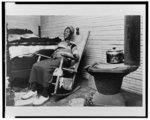By Si Kahn
My time with SNCC in the summer of of 1965 was so powerful, so emotional, so wrenching that it was years before I could begin to write about it, either in song or in prose. Finally, in my 2010 book Creative Community Organizing: A Guide for Rabble-Rousers, Activists and Quiet Lovers of Justice, I was able to write down this story.
One desperately hot afternoon in late August, working my way down one of the dusty back streets on the Black side of town, I stopped by a small house. An ancient-looking woman was rocking on the porch.
“Good afternoon, Ma’am,” I said.
She nodded and kept rocking.
“I’m from the Freedom Center,” I went on. “I wonder if I could talk with you for a minute or two?”
She nodded again and gestured towards a straight-backed chair opposite her. I sat down. I really wanted to ask how old she was, but it didn’t seem the polite thing to do.
She must have guessed my question. “You know,” she said, “I was born a slave.”
In my forty-five years as an organizer, there are a very few moments when I felt I was in the presence of some kind of special grace.

Continuation
“I was four years old when we got freed.”
I didn’t know what to say. I just sat there, in wonder, speechless.
The woman who had been born a slave reached out to me. “How can I help you?”
She had rescued me. “Ma’am, the president of the United States has signed a law saying that everyone has the right to vote.”
She cut me off, gently. “I read the papers. Every day. I know.”
“I was hoping you’d go with me to the courthouse to register to vote.”
She stopped rocking and leaned forward.
“Son,” she said, “I’m 105 years old. I don’t leave my rocking chair.”
I was caught between figuring out what year that meant she’d been born and trying to frame a response. All I could come up with was, “If you didn’t have to leave your rocking chair, would you register to vote?” It was half a nervous joke. I didn’t know what else to say.
“I would,” she said. “But I don’t ever leave my rocking chair.”
I went back to the Freedom Center. As usual, there were a number of young Black men there, some doing different kinds of volunteer work, others just enjoying this one piece of liberated territory in the midst of Forrest City. Still in awe at having sat and talked with someone who had been born a slave, I told them what I’d just seen and heard.
One of the Michigan locals of the United Auto Workers union had sent the Forrest City SNCC project a brand-new bright yellow four-on-the-floor three-quarter-ton Dodge pickup. One of the young men took the keys from where they hung on a nail by the front door and slid into the driver’s seat. The others climbed into the cab or the back of the truck.
They drove to where her house was located and stepped together onto the porch.
They lifted her, still in her rocking chair, carried her outside, and placed her, chair and all, in the back of the truck.
With the young men in the back kneeling next to her, each with a hand on the chair to steady it, they drove as slowly as they could, weaving their way through the Black community, up one street and down another: past the churches and the adjacent graveyards, the segregated elementary school and high school, the little grocery stores, Clay’s Funeral Home, and the Freedom Center.
As word spread, people poured out onto their porches, into their yards, to watch as she passed, sitting straight and proud in her chair, in the back of the bright yellow pickup they all recognized on sight. Everyone knew who she was, the eldest member of their community, the woman who had been born a slave—and they knew where she was going.
When there was no street untraveled, no place in the Black community left to trumpet the news, the young men turned towards the courthouse, parking directly in front of the entrance, where everyone passing by could see them.
Then they carried her in that throne up the courthouse steps and into the registrar’s office, so she could register to vote.
If that isn’t Freedom, what is?
